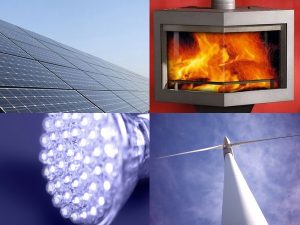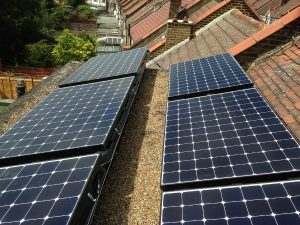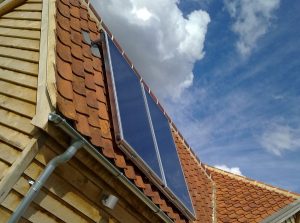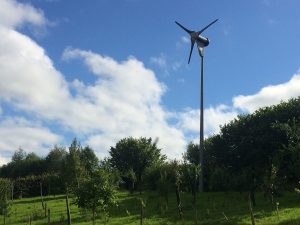This is an idea that allows you to heat water via solar electric panels instead of exporting surplus electricity to the National Grid. This makes sense because it then means that you can do the work yourself instead of hiring an (expensive) accredited installer – plus you can use second-hand gear.
Those of you who have watched my Youtube channel will be familiar with the way I like to try things rather than listen to the armchair theorists. So, I have been experimenting again, spending a bit of cash, and learning things new to me. This idea however is not new and is startlingly obvious, but works because of a relatively recent piece of equipment called a grid diverter.
Let’s retrace our steps a bit, previously the accepted way of creating hot water from solar was through solar water panels, which are good and absorb different solar wavelengths than solar electric panels. However to install such a water-based system is quite disruptive, commonly involving changing hot water cylinders, fitting pressure tanks and lots of plumbing. Fine if you are doing a household refit, but problematic, although the outcome is lots of hot water.

Mastervolt soladin 600 watt grid inverter.
Consider the alternative in the light of developments in the solar electric world. Solar electric (photovoltaic – PV) panels can be fitted anywhere there is direct sunlight, on a frame in the garden, on your workshop roof, the chicken shed etc. These are easily connected by two wires to a grid inverter mounted somewhere in the dry and with a mains power connection. You can then use your standard immersion heater for hot water and there is no major disturbance. There are other benefits that I will come to later.
A grid tie inverter takes the direct current (DC) output from a number of solar (PV) panels and converts it into alternating current (AC) suitable to mix in with the mains electricity. Think about it as pouring electricity into your mains connection, and this can be through a standard mains plug and socket for inverters up to about 1700 watts.
With a grid tie inverter the number and power of the panels need to be matched to the inverter, so the place to start is with the wattage. Each panel is rated for its nominal output in watts, so with a 1500 watt grid inverter you could use 6 panels rated at 235 watts, or 5 at 285 watts, but you do not have to fit the maximum number of panels as long as the collective panel voltage is within the grid inverter range. Different inverters have varying ranges, but I have noticed that the modern inverters have very wide acceptable working DC voltage range – something like 70 to 500 DC volts. This makes life easier as they will work with a wide range of panel numbers or specifications.

SMA 1200 imput details.
So as an example, take a grid inverter that works within the range of 130 to 320 volts. The 235 watt panels mentioned above will have an open circuit voltage of something like 37 volts. The panels are wired in series and this line of panels is called a string. Hence with six panels in a string the open circuit voltage will be: 6 x 37v = 222 volts, well within range. If you don’t have the room or cash for six panels you could fit five and that would still work but give out less power ( 37 x 5 = 185 volts). In the latter case the maximum output in good bright sunshine would be 235 x 5 = 1175 watts (1.17 Kw). As an alternative you could use a small 600 watt inverter like the blue Mastervolt that works between 40 and 150 volts and works well with 2 panels.

Six panels in series.
A grid inverter can be connected to any mains connection on your property as long as this will carry the power generated (the small ones are just plug in, see the Mastervolt photo). The power first goes into your home electrical circuit and helps to power the things using electricity at the time. If you don’t use it all then the surplus goes into the grid. If you use more than your generation then the extra is imported from the grid. So when the sun is shining that’s the best time to run the washing machine as you will mostly be powering it from your own generation.

SMA 1200 watt grid inverter.
The price of photovoltaic panels (PV) has plummeted, my first panels were £3 per watt last decade, and a recent (and repeatable) purchase of panels was at 0.35p per watt. A similar drop in the solar grid tie inverters has occurred and a second-hand market exists. All this in conjunction with a grid diverter means you can heat your water, run space heating, and contribute to powering you house from a system that is relatively easy to install.
So I have briefly described a grid tied PV system, but there is on more piece of equipment that pulls the whole thing together and makes it much more energy and cost effective. Namely the grid power diverter and there is a video on my channel showing the installation on one of these units. To find it type this into a search engine: “Immersun grid tie power diverter, zero carbon water heating” and you’ll find it.

Immersun diverter.
The Immersun diverter has a sensor that clips around one of your mains power supply cables next to your consumer unit. This tells the Immersun which way power is flowing and how much (import or export). There are several load circuits on the diverter and it powers these heating circuits only from your generated power, so if you are only generating 600 watts then that is all it will put into your immersion heater, and the diverted power will vary with the intensity of the sun on your panels (and the number of panels). If the water is up to temperature then the power is diverted to the second circuit which may be a storage heater. If you have a direct water heating system from a combi boiler then a pre-heat tank can be used. This means that the water is heated in a tank at mains water pressure, so hot water is fed into the boiler reducing the need for the gas boiler to provide any heat. Viridian tanks can take either conventional hot water panels or electric elements driven from the Immersun.
If you switch something on in the house then the generated power will go to that thing and the power diverted by the Immersun will be reduced accordingly, or if it’s a large electrical load it may import power. The main thing is that for the heating circuits connected to the Immersun no power will be drawn from the mains and so there will be no cost. There is a boost function for those grey days in winter and the use of this is down to family education. When your various heating circuits are up to temperature (max 3.2 Kw per circuit) and the thermostats have switched off then the surplus power is exported to the grid. This photo of the Immersun LCD screen shows the immersion heater up to temperature and the amount of electricity being exported. If you were running the washing machine at this point it would be zero carbon and zero cost.

Immersun LCD screen.
So there you are, an alternative to solar water panels that are easy to fit, will power other things in the home, and can export power when you don’t need it. You can fit second-hand panels and inverters without having to use an expensive MCS accredited engineer. As long as you use a grid power diverter you can gain all the benefits from the electricity with a much lower installation cost. There will be no registering of the system for the now laughable feed-in tariff (thanks to the nasty party who only look after their own).
This idea will work for a wind turbine too, but really only if you live in a very windy area.
I hope this helps you to reduce your overheads and carbon footprint at an acceptable cost.
My video channel is here with lots of wind and solar ideas and experiments:
https://www.youtube.com/user/TheInfoworks/videos
Andy Reynolds
Practitioner in lowimpact living and author of Wind and Solar Electricity






12 Comments
We’re really fortunate in having had our PV system just (like hours just) before the FIT changed. Since they don’t actually measure what is exported, just paying a nominal % figure, it strikes me we could heat a hot water tank from surplus power and still get the FIT even if we exported nothing. LOL
I’m sure Andy will answer this, but as I understand it, the feed-in tariff is payable for everything you generate, whether you use it, export it or waste it. We’ve got solar, and they just assume that we export 50% to the grid, and that’s what they pay us for the generation/export. But the FiT is additional to this.
What Andy’s talking about is using second-hand kit and installing yourself (so you won’t get FiT and they won’t pay you for exporting), but you use every drop of the electricity you generate, because you use any surplus for contributing to water heating.
But – you’re right. I assume we could install a pre-heat tank (we’ve got a combi) so that we don’t export anything to the grid – but they’ll continue to assume that we export 50%!
(they only pay about 4p per unit for what we export, which is scandalous).
You are both right, what ever you do it will not change the fits payment. The fits link to the MCS certification cut the practical home mechanic out of the loop by preventing from fitting their own systems. Now with the use of the Immersun power diverter the home mechanic can fit second hand gear, generate power, and prevent export. I feel with unregistered systems it is probably a good idea to prevent all export, so to that end the Immersun is capable of preferentially powering three different 3.2Kw loads. The next video will show how to connect the third heater. I feel it is a huge step so that people to regain control over their power supply. One more step in reducing the big generators strangle hold..
Great article Andy. Just a note that for the true DIY purist there is the option of using a branch of Open Energy Monitor to achieve the same result. http://www.mk2pvrouter.co.uk/ is a very well documented project that achieves the same result but is also open to lots of additional logging and control.
I have a home built solar system that uses an array of solar panels through a 40A charge controller to charge a 24V battery bank then via an inverter to supply mains voltage electricity to the house this switches off when economy 7 off peak comes on at night to run our high power appliances washing machine dish washer etc.. I want to add a home made power generating wind mill located 50M from the house and later a remote larger solar array . I do not want to buy a second battery bank! at 24V the transmission losses are awful if i tried to bring the 24V supply up to the house it would involve thick expensive heavy cables
The inverter in the house is a pure sinewave supply Could i put a grid tie inverter on to the windmills output or onto a second remote solar array and then connect the grid tie inverter to my 220v pure sinewave system rather than its “normal ” connection to the grid so that it fed power into my own grid/ tsystem or would the in-phase voltage appearing across the output terminals of the inverter damage it???? My inverter is a LF transfomer o/p 5000W rated 20,000 w peak pure sinewave inverter and i am reluctant to kill it !!!.
grid diverter is brilliant if you are connected in on a tarriff but on a homebrew system its betetr to dump any unused capacity into a lower power 2kw immersion heater 240W panels in series go straight in with no controller and no overload on panels output
If you export any power without having had a rip off mcs engineer system installed does it not go into the grid without you being paid anything for it??. I bought a modern digital meter off the internet and if you run power through them backwards they do not count down whereas the old fashioned analogue supply meter would happlly run in either direction
Hi, yes you are right to be concerned, almost all inverters will not accept manis power put into the output, except bi-directional ones. I assume your battery bank and inverter is close to your house. On our system the battery shed is close to the panels and turbine, and inverted power is sent to the house. Some of our panels are 60 mtrs away from the battery shed and we reduce losses by running a 48v DC system and using 10mm solar cable for the connection runs. Turbines are great but solar is passive and much easier to fit and work with. If you want to treat a turbine build as an engineering project then that’s fine, otherwise I would suggest more panels
HI, yes inverters do not take kindly to mains power on the output. To get round the volt drop problem we use a 48v system and have the battery shed near the turbine and panels. Having said that we have 60 mtr runs from panels to batteries and so we use 10mm solar cable in a conduit. Turbines are helpful for winter power but have their own problems, whereas panels are passive and dont self destruct. From experience it takes more time to build a turbine control system that to make the turbine, great for an engineering project, but panels are easier to control. Cheers
HI, yes inverters do not take kindly to mains power on the output and will go pop. To get round the volt drop problem we use a 48v system and have the battery shed near the turbine and panels. Having said that we have 60 mtr runs from panels to batteries and so we use 10mm solar cable in a conduit. Turbines are helpful for winter power but have their own problems, whereas panels are passive and don’t self destruct. From experience it takes more time to build a turbine control system that to make the turbine, great for an engineering project, but panels are easier to control. Cheers
Hi. I understand your view and direct dc heating is fine as long as there are no thermostats in the system. Switching high voltage DC will cause large plasma arcs unless they are suppressed with high voltage capacitors (about 47 uf). The direct way is much cheaper but less flexible. By using a grid inverter and a diverter the power is available anywhere in the house power system. It then goes into heating when it is not being used eleswhere and is about to be exported. The diverter prevents the export and dumps it in a series of dedicated dump loads. Cheers
Hi, some of the earlier wheel meters do go backwards, but later models do not. Solid state units only work one way. The main thing about a diverter is that it prevents export. This is the icing on the cake, you can fit second hand panels and inverters and get the full benefit of the power without paying to the MCS cartel. Rememer this power is available anywhere in your system and when it is not required it is dumped into a dedicated load. Cheers